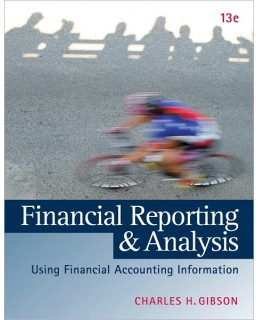This is completed downloadable of Test Bank for Financial Reporting and Analysis, 13th Edition, Charles H. Gibson

Product Details:
- ISBN-10 : 1133188796
- ISBN-13 : 978-1133188797
- Author: Charles H. Gibson
Learn to prepare and use financial statements with numerous actual examples, current cases, and financial statements from real companies like Nike and Best Buy, that keep financial accounting interesting and relevant.
Table of Content:
- Chapter 1: Introduction to Financial Reporting
- Development of Generally Accepted Accounting Principles (GAAP) in the United States
- Additional Input – American Institute of Certified Public Accountants (AICPA)
- Emerging Issues Task Force (EITF)
- A New Reality
- FASB Accounting Standards Codification (Codification)
- Traditional Assumptions of the Accounting Model
- Harmonization of International Accounting Standards
- Financial Reporting Standards for Small and Medium-Sized Entities (SMEs)
- Using the Internet
- Summary
- Questions
- Problems
- Cases
- Endnotes
- Chapter 2: Introduction to Financial Statements and Other Financial Reporting Topics
- Forms of Business Entities
- The Financial Statements
- The Accounting Cycle
- Auditor’s Opinion
- Management’s Responsibility for Financial Statements
- The SEC’s Integrated Disclosure System
- Proxy
- Summary Annual Report
- The Efficient Market Hypothesis
- Ethics
- Consolidated Statements
- Accounting for Business Combinations
- SEC – Paper Filings – EDGAR – XBRL
- Summary
- Questions
- Problems
- Cases
- Endnotes
- Chapter 3: Balance Sheet
- Basic Elements of the Balance Sheet
- Quasi-Reorganization
- Accumulated Other Comprehensive Income
- Employee Stock Ownership Plans (ESOPs)
- Treasury Stock
- Stockholders’ Equity in Unincorporated Firms
- International Consolidated Balance Sheet (IFRS)
- Summary
- Questions
- Problems
- Cases
- Endnotes
- Chapter 4: Income Statement
- Basic Elements of the Income Statement
- Special Income Statement Items
- Income Taxes Related to Operations
- Earnings per Share
- Retained Earnings
- Dividends and Stock Splits
- Legality of Distributions to Stockholders
- Comprehensive Income
- International Consolidated Income Statement (IFRS)
- Summary
- Questions
- Problems
- Cases
- Endnotes
- Chapter 5: Basics of Analysis
- Ratio Analysis
- Common-Size Analysis (Vertical and Horizontal)
- Year-to-Year Change Analysis
- Financial Statement Variation by Type of Industry
- Review of Descriptive Information
- Comparisons
- Relative Size of Firm
- Other Library Sources
- The Users of Financial Statements
- Summary
- Questions
- Problems
- Chapter 6: Liquidity of Short-Term Assets; Related Debt-Paying Ability
- Current Assets, Current Liabilities, and the Operating Cycle
- Current Assets Compared with Current Liabilities
- Other Liquidity Considerations
- Summary
- Questions
- Problems
- Cases
- Endnotes
- Chapter 7: Long-Term Debt-Paying Ability
- Income Statement Consideration When Determining Long-Term Debt-Paying Ability
- Balance Sheet Consideration When Determining Long-Term Debt-Paying Ability
- Special Items That Influence a Firm’s Long-Term Debt-Paying Ability
- Joint Ventures
- Contingencies
- Financial Instruments with Off-Balance-Sheet Risk and Financial Instruments with Concentrations of C
- Disclosures about Fair Value of Financial Instruments
- Summary
- Questions
- Problems
- Cases
- Endnotes
- Chapter 8: Profitability
- Profitability Measures
- Trends in Profitability
- Segment Reporting
- Revenues by Major Product Lines
- Gains and Losses from Prior Period Adjustments
- Comprehensive Income
- Pro-Forma Financial Information
- Interim Reports
- Summary
- Questions
- Problems
- Endnotes
- Chapter 9: For the Investor
- Leverage and Its Effects on Earnings
- Earnings per Common Share
- Price/Earnings Ratio
- Percentage of Earnings Retained
- Dividend Payout
- Dividend Yield
- Book Value per Share
- Stock Options (Stock-Based Compensation)
- Restricted Stock
- Stock Appreciation Rights
- Summary
- Questions
- Problems
- Cases
- Endnotes
- Chapter 10: Statement of Cash Flows
- Basic Elements of the Statement of Cash Flows
- Financial Ratios and the Statement of Cash Flows
- Alternative Cash Flow
- Procedures for Development of the Statement of Cash Flows
- Summary
- Questions
- Problems
- Endnotes
- Summary: Summary Analysis Nike, Inc. (Includes 2011 Financial Statements of Form 10-K)
- Nike-Background Information
- Chapter 11: Expanded Analysis
- Financial Ratios as Perceived by Commercial Loan Departments
- Financial Ratios as Perceived by Corporate Controllers
- Financial Ratios as Perceived by Certified Public Accountants
- Financial Ratios as Perceived by Chartered Financial Analysts
- Financial Ratios Used in Annual Reports
- Degree of Conservatism and Quality of Earnings
- Forecasting Financial Failure
- Analytical Review Procedures
- Management’s Use of Analysis
- Use of LIFO Reserves
- Graphing Financial Information
- Management of Earnings
- The Housing Bust
- Valuation
- Summary
- Questions
- Problems
- Cases
- Endnotes
- Chapter 12: Special Industries: Banks, Utilities, Oil and Gas, Transportation, Insurance, and Real E
- Banks
- Regulated Utilities
- Transportation
- Insurance
- Real Estate Companies
- Summary
- Questions
- Problems
- Cases
- Endnotes
- Chapter 13: Personal Financial Statements and Accounting for Governments and Not for-Profit Organiza
- Personal Financial Statements
- Accounting for Governments
- Accounting for Not-for-Profit Organizations Other Than Governments
- Summary
- Questions
- Problems
- Cases
- Endnotes
- Appendix: Thomson ONE Basics and Tutorial
- Glossary
- Bibliography
- Index





